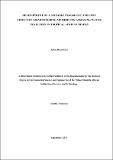| dc.description.abstract | The needs of tropical African countries to develop their own biomonitoring indices using local macroinvertebrates as opposed to adoption or relying on non-tropical indices in biomonitoring programmes for assessing freshwater pollution were discussed. The discussion build-up involved: (i) reviewing of existing indices from non-tropical regions and their adoption setbacks in assessing pollution in tropical African rivers; (ii) testing of key review findings in the field at a small scale and then at a wide scope by characterizing macroinvertebrates while examining environmental variables; (iii) assigning pollution sensitivity ratings of macroinvertebrates based on related scoring systems and the help of PRIMER7 software; (iv) determination of macroinvertebrates response towards nutrients loading, and; (v) developing suitable and cost-effective biomonitoring method. The review paper, pilot and detailed studies and toxicity test study were aimed at laying the groundwork needed to develop a simple, quick and advanced tropical biomonitoring tool for initial application on Tanzanian rivers.
Collectively, ninety seven macroinvertebrate families belonging to seventeen orders were observed at 85 sampling stations, representing 46 reference and 39 monitoring sites along Tanzanian rivers. All observed orders were subjected to six stepwise criteria to identify the one with a potential of discriminating reference from monitoring sites. The criteria include: numerical truncate test, Mann-Whitney test, inter-quartile overlap levels in Box-and-Whisker plots, Spearman rank correlation (rs) analysis, more diverse order (with > 10 taxa) and validation test. Ephemeroptera (E), Diptera (D), Odonata (O) and Trichoptera (T) orders that comprised the 55% (N = 97) of all Tanzanian families met all test criteria after being found with abundances > 2% upon truncate test, a p-value < 0.05 in a Mann-Whitney U test, a sensitivity score of 3, rs < 75% (with p < 0.005), higher number of taxa (n > 10) and separating reference from monitoring sites and thus, chosen to develop EDOT index. Being developed using only four and most diverse local orders, minimizes data variability, needs for great expertise and time in the field, the credibility that is not hitherto possessed by existing indices. | en_US |

